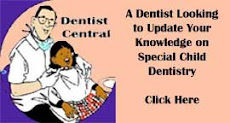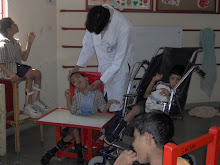The story of Tiresias is a familiar to those who have read Greek mythology. Tiresias who was supposedly struck blind by the godess Athena in a fit of rage, was given the gift of foresight. While he could predict the future clearly there was nothing he could do to change it. Special care dentists today find themselves in a similar predicament. With the unraveling of the human genome and the giant leaps taken in the field of molecular genetics, researchers today can accurately pin-point the genetic defect behind every conceivable deformity and the location of the genes involved. But can this knowledge truly benefit patients with special care needs? Can the vast list of the so called "tooth genes" actually ease suffering. Can the dentist's diagnostic knowledge of genetics actually impact treatment of individuals with special health care needs? Or are we staring at billions of dollars of cutting edge research whose ultimate purpose may only be to inform us with pin-point accuracy what generations have known through experience. DCSN looks at the evolution of modern genetics and the impact it has had on dental research, and the possible clinical impact of that research.
A monk, some pea plants and the century that followed
In 1865 an Augustinian friar named Gregor Mendel published a paper in a small but respected Hungarian journal. Titled, Versuche uber Pflanzen-Hybriden, or the debate over plant hybridization. This seemingly mundane title in a (then) Hungarian journal was to lay the building blocks of modern genetics. In an era of science versus the church, Mendel was clearly on the wrong side. At a time when evolution,Darwin, and constant change were in vogue, Mendel's concept of unchangeable genes clearly did not go down well. It was to be 35 years before researchers were to "rediscover" his work. In 1901, Hugo de Vries, Carl Correns and Tschermark simeltaneously found that their work in trying to explain the inhertience of genes had already been proven by an Austro-Hungarian monk three decades ago.
The Twentieth century can truly be proud of several leaps in science, but none bigger than those taken in the field of genetics.
Cracking the Code - From the Double helix to the entire Human Genome
When John Watson and Francis crick discovered the double helix code in 1954, Crick is rumored to have announced in a local pub, "We have discovered the secret of life". They may have well discovered the code to reading the secret but it would be almost half a century before those secrets were uncovered. In the early 1970s, that a variety of cytogenetic methods were discovered that produced distinct bands on each chromosome making it possible to give each gene a specific “genetic address”. Even though the first draft of the entire human genome was completed only in 2001 , by the 1990’s researchers in oral biology were studying the dental implications of the decoding of the human genome. OF all all the newly discovered genes, the gene that was of greatest interest to researchers were the homeobox genes.Homeobox (Hox) genes are a set of genes that determine organizational pattern in vertebrates. First isolated in the fly Drosophila melanogaster the temporal and spatial control of Hox gene expression is essential for correct patterning of many animals. Remarkably the order of these genes and their functions are similar in almost all mammals, thus giving rise to a new hero in genetic studies, the Mouse.
OF all all the newly discovered genes, the gene that was of greatest interest to researchers were the homeobox genes.Homeobox (Hox) genes are a set of genes that determine organizational pattern in vertebrates. First isolated in the fly Drosophila melanogaster the temporal and spatial control of Hox gene expression is essential for correct patterning of many animals. Remarkably the order of these genes and their functions are similar in almost all mammals, thus giving rise to a new hero in genetic studies, the Mouse.
Of Mice and Men - Understanding Craniofacial Genetics
One does not have to be a geneticist to know that craniofacial growth in general and anomalies in particular have a genetic component. For centuries we have commented on someone having their mother's eyes or father's nose. But locating exactly which genes cause those traits and where those genes are located is a lot more difficult. The advent of genetic mapping gave researchers a simple way to find the genes. They would damage certain genes in mice and observe the effect it had on the growth. They either did this by targeting a particular gene during embryological development, and then knocking them out, giving rise to the term knockout mice; or they extracted genes they suspected of certain anomalies, injected these genes into the embryos of surrogate mice mothers and observed the offspring , called transgenic mice, for changes. Using knockout and transgenic technology, by the late 1990s investigators were well on their way to identifying and locating genes that were responsible for human growth, development or the lack thereof.
Where are these genes - the genetic address
In 1913 Bridges showed that genes were located on chromosomes,but it was not until the early 1970s, that a variety of cytogenetic methods were discovered that produced distinct bands on each chromosome making it possible to give each gene a specific “genetic address”. Each gene is numbered by the chromosome it is located on, p or q to state whether it is on the short (petit -p) or the long (q) arm and a number denoting the band on which the gene lies. A more specific address would also include the actual number of the gene on the band. For example 23p2.12 would indicate that the gene lay on the short arm of chromosome 23 and was the 12th gene on the second band.
Where do you find them?
The entire human genome is available online, as are the partial or total genomes of several mammals, birds, plants, fungi and bacteria.. However of greater interest to the special care dentist is the project termed Online Mendelian Inheritence in Man or OMIM. The project describes over 12000 genes that are known to be associated with Mendelian traits in man. In addition the database also gives a full text description of the gene, its discoverer, the physical characteristics it is responsible for (Phenotype) and its genetic pattern (genotype).
So?
So now at the click of a mouse (no pun intended) you can know not only that, that a nonsense mutation in MSX1 causes the tooth agenesis and nail dysgenesis associated with the Witkop Tooth and Nail syndrome, but also that the gene responsible is located on the short arm of chromosome 4 at 4p16.1-16.3. and can often manifest with the Woff-Hirschonn syndrome.This but one example of many impressive sounding genetic addresses.
However what it does not tell us is what we can do about it. It offers no cure, no relief, no counsel for a parent anxious for the welfare of her child. Tiresias' curse... One hopes not.
The ultimate aim, if not dream of every genetic engineer (whether or not they would admit it) would be to use this knowledge to create a better life for their patients. But while genetic engineering has produced some successes, especially in the production of hormones such as growth hormone and insulin, and while experimental tooth regeneration techniques such as tissue scaffolding and tooth engineering are the first steps being taken in the field of craniofacial research we still have a long way to go.
In the end it is not the aim or within the scope of this article to debate the moral and ethical issues that surround genetic engineering. We at DCSN however hope to be around on the day when genetics for the special care dentist is actually a tool to alleviate suffering, rather then merely being able to accurately predict its cause.






